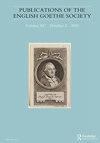The Hafis-Goethe-Denkmal and Cultural Sounds? as Artistic Responses to Goethe’s Divan: Between Close Reading and Cultural Politics
IF 0.1
3区 文学
0 LITERATURE, GERMAN, DUTCH, SCANDINAVIAN
引用次数: 0
Abstract
ABSTRACT This paper examines two works of contemporary art, a sculpture-cum-civic monument and a sound installation, which respond to Goethe’s Divan. The discussion combines a critical review of the political climate within which the works were conceived with original interviews with the artists to offer close analysis of the works. I evaluate the relative impact that the Divan and scholarship on it had upon the two works. I further ask whether the artists and their sponsors felt compelled to downplay more contentious themes found in that legacy, given the ideal of intercivilizational dialogue so prominent in the discourses of German-Iranian cultural diplomacy. The paper offsets this critical reading, however, by highlighting the quite sophisticated treatments of occidental-oriental relations achieved by both works within their respective media.哈菲斯-歌德-登克马尔与文化之声?对歌德的“Divan”的艺术回应:在细读与文化政治之间
摘要本文考察了两件当代艺术作品,一件雕塑兼市民纪念碑和一件声音装置,它们回应了歌德的《Divan》。讨论结合了对作品构思所处政治环境的批判性回顾,以及对艺术家的原创采访,对作品进行了深入分析。我评估了Divan及其学术对这两部作品的相对影响。我进一步问,鉴于文明间对话的理想在德国-伊朗文化外交的话语中如此突出,艺术家及其赞助商是否觉得有必要淡化这一遗产中更具争议的主题。然而,这篇论文通过强调两部作品在各自的媒体中对西方和东方关系的相当复杂的处理来抵消这种批判性的解读。
本文章由计算机程序翻译,如有差异,请以英文原文为准。
求助全文
约1分钟内获得全文
求助全文
来源期刊

Publications of the English Goethe Society
LITERATURE, GERMAN, DUTCH, SCANDINAVIAN-
CiteScore
0.10
自引率
0.00%
发文量
15
 求助内容:
求助内容: 应助结果提醒方式:
应助结果提醒方式:


